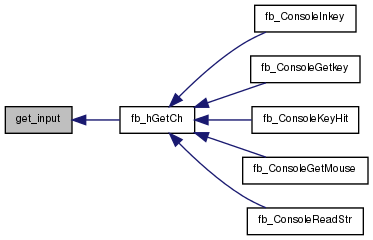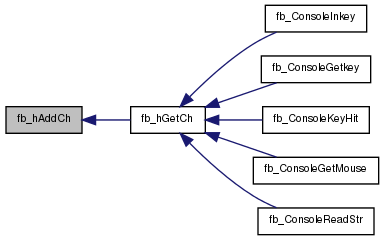
Go to the source code of this file.
Data Structures | |
| struct | NODE |
| struct | KEY_DATA |
Macros | |
| #define | KEY_BUFFER_LEN 256 |
| #define | KEY_MOUSE 0x200 |
Typedefs | |
| typedef struct NODE | NODE |
| typedef struct KEY_DATA | KEY_DATA |
Functions | |
| static void | add_key (NODE **node, char *key, short code) |
| static void | init_keys () |
| static int | get_input () |
| void | fb_hAddCh (int k) |
| int | fb_hGetCh (int remove) |
| FBSTRING * | fb_ConsoleInkey (void) |
| int | fb_ConsoleGetkey (void) |
| int | fb_ConsoleKeyHit (void) |
Variables | |
| static const KEY_DATA | key_data [] |
| static int | key_buffer [KEY_BUFFER_LEN] |
| static int | key_head = 0 |
| static int | key_tail = 0 |
| static NODE * | root_node = NULL |
Macro Definition Documentation
| #define KEY_BUFFER_LEN 256 |
Definition at line 12 of file io_inkey.c.
| #define KEY_MOUSE 0x200 |
Definition at line 14 of file io_inkey.c.
Typedef Documentation
Function Documentation
|
static |
This builds a simple tree that allows fairly easy lookup of the terminal escape sequences (keys) that were added. For example:
after adding these key sequences:
[a1, [a2, [b1, [b2
the tree looks like: (| = child, - = sibling)
root -> <[>
|
<b>-----------<a>
| |
<2>----<1> <2>----<1>
Definition at line 59 of file io_inkey.c.

| int fb_ConsoleGetkey | ( | void | ) |
| FBSTRING* fb_ConsoleInkey | ( | void | ) |
| int fb_ConsoleKeyHit | ( | void | ) |
| void fb_hAddCh | ( | int | k) |
| int fb_hGetCh | ( | int | remove) |
Definition at line 208 of file io_inkey.c.


|
static |
Definition at line 144 of file io_inkey.c.


|
static |
Lookup the terminal escape sequences (termcap database entries) corresponding to the id strings defined in the key_data table above (only key presses here).
For example, the id string "kh" corresponds to the HOME key, and tgetstr("kh", NULL) returns the escape sequence that the terminal will send when the HOME key was pressed.
These typically vary from terminal to terminal (for example TERM=xterm vs. TERM=linux) and perhaps depend on other factors aswell.
Definition at line 99 of file io_inkey.c.


Variable Documentation
|
static |
Definition at line 56 of file io_inkey.c.
|
static |
Definition at line 30 of file io_inkey.c.
|
static |
Definition at line 56 of file io_inkey.c.
|
static |
Definition at line 56 of file io_inkey.c.
Definition at line 57 of file io_inkey.c.




